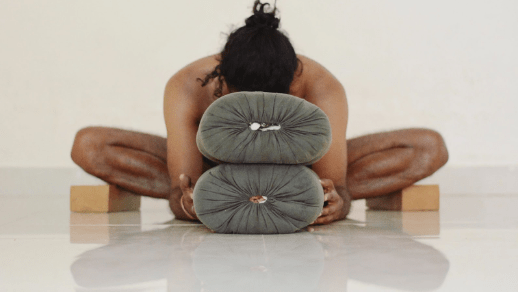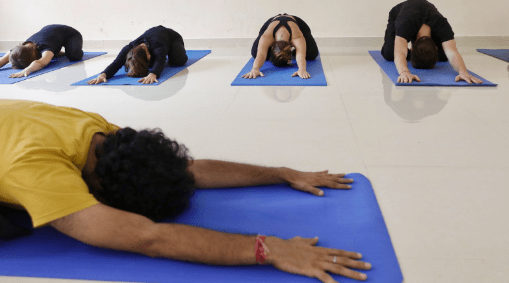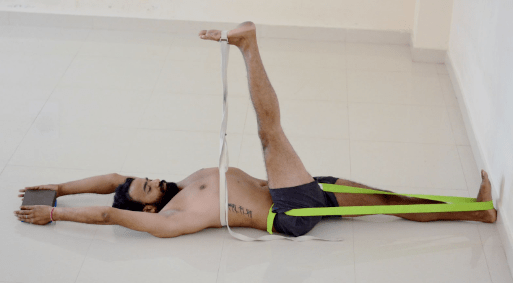What is Yin Yoga?
In this fast-paced world, discover the power of mindful stillness through Yin Yoga. This style of yoga invites you to pause, breathe deeply, and surrender yourself into stillness. In Yin Yoga, you don’t have to worry about perfecting your poses or pushing your physical limits, but rather, you have to seek out comfort in discomfort and connect with your body’s wisdom.

Yin yoga is a passive style of yoga that includes specific, long-hold poses held for 3 to 10 minutes at a stretch.
Yin Yoga is a fairly recently created style of yoga. It was developed by Paul Grilley in 1980. He derived the moves of Yin yoga from Hatha yoga practised by monks.
In yin yoga, each pose is held for 3 to 10 minutes. This improves the flexibility of the deeper tissues of your body to stretch fully. The goal of yin yoga is to enhance the range of motion and the flexibility of tissues.
It targets ligaments, bones, joints and fascia, with its focus on flowing movements that build strength.
The proper flow of energy or prana is essential for good health. Energy flow up the body is known as Yin, and the downward flow is known as Yang. Energy can only flow freely when there are no blocks. The Yin Yoga sequence opens up the movement of energy through the body.
Each Yin Yoga pose works on one of the five elements of the body. The five elements according to Chinese beliefs are: water, wood, fire, metal and Earth. The elements directly affect the different organs of the body.
Water element – kidney and bladder.
Wood element – liver and gallbladder.
Fire element – heart and small intestine.
Metal element – lungs and large intestine.
Earth element – spleen and stomach.
Each element aligns with different seasons, organs, emotions, bio functions, direction of energy flow and meridians or energy channels. When the five elements are in balance the energy flows freely through the body. When elements are imbalanced, energy flow is blocked or restricted. This state presents itself in emotional turmoil or physical illness.
These five elements work in cycles, and each cycle is interconnected with the next one. Each element supports and gives way to the next element. This is known as the Feeding Cycle. For e. g., the water cycle restrains the fiery cycle. Just like the rainy season restrains the summer heat.
Each meridian or energy channel is connected to a different pair of organs. Yin Yoga posturrs help to stimulate the specific channels and remove blockages and restrictions, ensuring a smooth flow of energy. Yin Yoga helps to bring us back into balance.

Even if you are a seasoned yoga practitioner, you will find that the gentle moves of Yin Yoga will offer you deep relaxation after a yoga session and increase flexibility as a pre-yoga session. There are many mental and physical benefits of this yoga style.
Improves flexibility:
Yin Yoga works on the Yin tissues of the body, also known as the fascia or connecting tissues. Yin yoga gently stretches the connecting tissues. These tissues are stretched by a long, slow hold which stretches them gently but wholly. The fascia responds best to this type of yoga by making them more flexible and stronger.
Yin Yoga for stress relief and mindfulness:
Doing 30 minutes of yin yoga will help to release your muscles and calm your hectic mind. A series of soothing poses will relax your body and ease away your tension. The log hold allows the parasympathetic nervous system to become active, which gives your mind permission to rest. Some of the poses for gentle relaxation are:
1. Gentle seated neck and side stretches, done slowly while breathing deeply and holding the pose for several breaths.
2. The child poses with a supporting bolster. Bend forward and relax your weight into the bolster. Close your eyes, breathe deeply, and come out of this pose slowly and with mindfulness
3. Puppy pose. Stay in this hip-elevated pose for as long as you comfortably can. Don’t overdo the stretching. Breathe deeply and invite the tension to release.
4. Supported Sapta Baddha Konasana. Use props as suggested to ease into this pose. Rest your back on the bolster and your arms at your sides. Breathe deeply and hold for as long as you can.
5. Supported Savasana. Place a pillow beneath your knees and lie down on your back. Stay in this pose as long as you wish and get the benefit of complete relaxation and calmness.

Benefits of Yin Yoga for Joint Health:
Yin yoga focuses on stretching the connecting tissue of the joints. This stretch releases the synovial fluid, which serves as the ambrosia for the joints. This fluid lubricates the joints and improves joint mobility. This especially helps those with stiffness, restricted joint movements and joint surgery to heal.
Some poses that are beneficial for increasing joint mobility and elevating stiffness are:
1. Child pose or Balasana. This pose relaxes the back and stretches the hips and thighs. It relieves stress and induces a sense of calmness.
2. Baddha Konasana or Butterfly pose. Helps to increase the flexibility of the hips and groin.
3. Dragon pose. It releases tension in the hips and spine. It opens the hip joint and the groin deeply.
4. Sphinx pose. This pose involves backbending and gently stretches the spine and the back. It relieves lower back pain and improves posture.
5. Supported Fish pose. Done with the aid of supportive props, like bolster or pillows, this pose opens up the chest and throat. It relieves tension in the neck area.
Yin Yoga works as an effective tool in soothing a restless nervous system and quieting the mind. If you want a restful night of deep sleep, then follow these five Yin Yoga poses.
1. Legs up the wall pose: This pose restores your legs by allowing the blood to flow back towards your upper body. It refreshes the heart, lungs, lower back. It relieves water retention and reduces stress. Sit down facing the wall and slowly lie down whilst pushing your legs up the wall. Keep your back and head flat on the floor and arms spread out. Hold the pose for 5 minutes.
2. Child pose: This pose releases shoulder muscle tension, stretches lower back and calms the mind. Place the pillow in the center of the mat. Sit with your knees wide and rest your face and chest on a pillow with your face to one side. Extend your arms in front of you. Hold pose for 5 minutes. Then change the side of your face and repeat.
3. Reclined butterfly: This pose opens and soothes the heart, lung and chest. It improves flow of oxygen to organs and the brain. Lie on your back, bend your knees and open legs to sides with soles touching. Hold pose for 5 minutes.
4. Reclined twist: This pose stretches the back, tones the organs and soothes digestion. With knees bent, lie on your back and cross your legs. Arms can be straight out or bent at the elbows. Exhale and twist your knees to one side. Turn your knees in the opposite direction. Hold for 5 minutes. Inhale and release pose. Repeat on the other side.
5. Supported Savasana: This pose lowers blood pressure and muscular tension. Improves immunity, manages stress and reduces pain. Lie on your back with a pillow under your knees. Extend your legs and arms long and wide. Relax into the pose. Detach yourself from your thoughts and hold this pose for 10 minutes.
Swap your Netflix and scrolling social media and practice these asanas for a great sleep.
There are many different forms of yoga one can practice. It is best to find a style that suits you and complement it with the gentle practice of Yin Yoga.
Yin Yoga and Vinyasa Yoga
Yin Yoga and Vinyasa yoga when combined is referred to as Yin Yang Yoga. Start your practice by doing Vinyasa yoga for the first half. This will help you to burn off calories, energize your body and open up your muscles.
Yin Yoga should be practised in the second half as it helps your body to slow down and relax.
Yin Yoga and Hatha Yoga
Hatha yoga is a mix of yoga poses, meditation and breathing techniques. It strengthens your body and mind, and improves posture. Yin Yoga and Hatha Yoga can both be practiced together, because both are forms of mindful yoga and go well together.
Once you decide to practice Yin Yoga, you will need to create a calm and peaceful environment. You can use props like pillows, bolsters, bands and blocks to help you with the deep stretches, the long holds and slow movements. Try not to compare yourself with others. Follow your own pace suited to your body. Yin Yoga forges a deep connection with your body and mind, and is the best form of yoga to practice in these times of stressful living.
Interested in becoming a yoga teacher?
Upcoming events and latest blogs